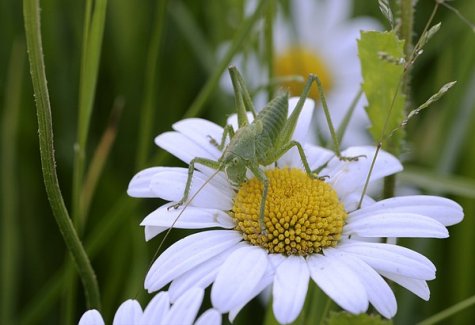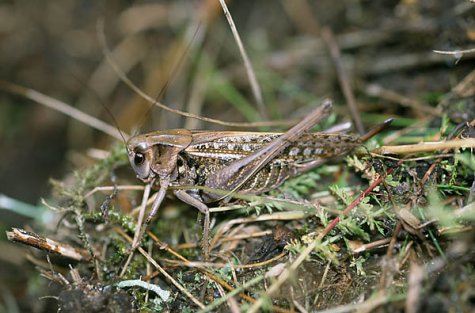Cricket time
Photos: Arne Ader
Translation: Liis
Singing cricket on ox-eye daisy
Singing cricket Harilik lauluritsikas Tettigonia cantans
Great green bush cricket Roheline lauluritsikas Tettigonia viridissima
Wartbiter Heinaritsikas or käsnasalvaja Decticus verrucivorus
The crickets are nicely distributed in Estonia: the singing crickets live on the mainland and the great green bush cricket we hear and meet on the islands. In addition to their exterior and behaviour their „song“ differs too. The sawing of the crickets in a way gives notice that mid-summer this year is behind us.
Comparing the crickets of the mainland with grasshoppers, they are considerably larger: body length more than three centimetres as is the length of the wings. The feelers (antennae) of the crickets are also long, reaching over the body length, the feelers of grasshoppers are short. The singing cricket can be encountered nearly everywhere except in a deep forest, so there are enough living places. Their „song“, or stridulation, sounds as a strong chirping, audible far away, from treetops or high shrubs. Our large crickets are preying insects, sometimes rarely plants are enjoyed; smaller relatives will get no quarter.
The great green bush cricket is a near relative to the crickets on the mainland, living in Hiiumaa and western Saaremaa, preferring high vegetation and on the shore sings from reeds.
As fits the name – green, in size maybe the largest insect in Estonia: body length a little more than 4 centimetres and the wings nearly 6 centimetres. The „song“ differs little from the mainland crickets, is simply a little slower, with pauses and more military, reminding of the clatter of a machine gun. The real singing urge comes in late night, but the clatter, with pauses, can be heard in daytime as well
.
.
Wartbiter
Wartbiters occur in the whole of Estonia, inhabiting wooded meadows, hayfields, forest verges, forest clearings as well as bogs and fens. Gender can be largely determined by size: the males stay below three centimetres and the females can be up to one and a half centimetre larger. Wartbiters vary in colour – basically green with brown spots. The „song“ sounds as if someone were sewing on a sewing machine; we hear them in the morning and in daytime. When evening comes wartbiters fall silent.
The name wartbiter or „wartspitter“ is inherited from our forefathers. On catching a wartbiter the insect regurgitates its gut contents through its mouth, and that may cause a slight prickling on the hands. It was believed that if warts on the skin were smeared with this brown liquid they would disappear.
But we have also short-winged coneheads (Conocephalus dorsalis), dark bush crickets (Pholidoptera griseoaptera), bog bush crickets (Metrioptera brachyptera)...










